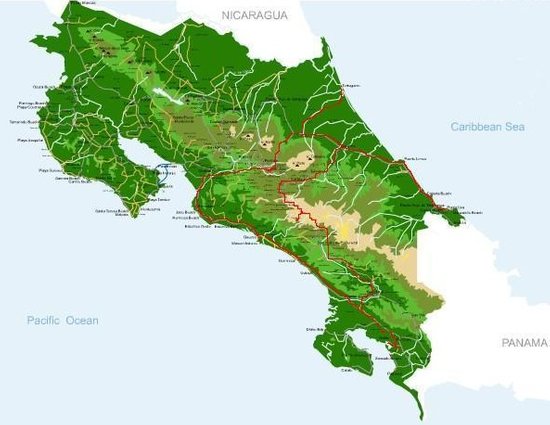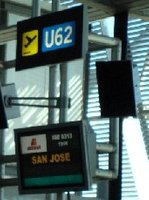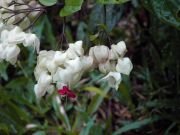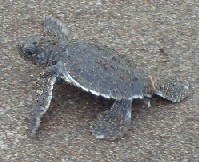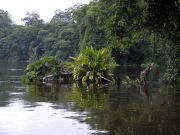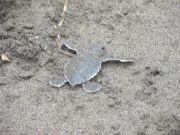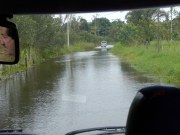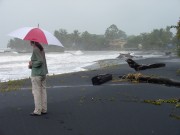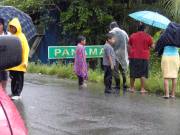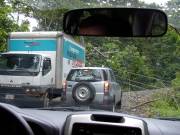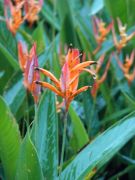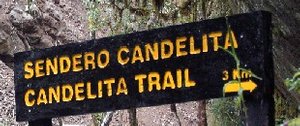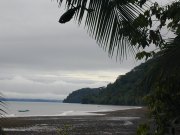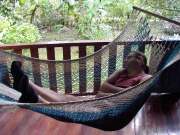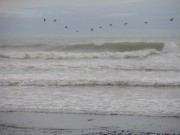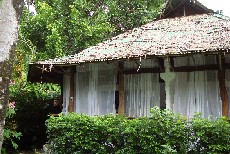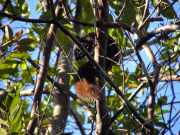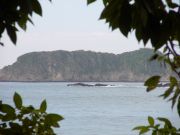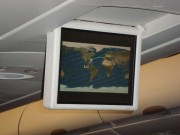ScubaTimo
Pagina over duiken en reizen in binnen- en buitenland
Website about scuba diving and traveling around the globe
2008 Tour South Costa Rica
From Monday November 17th to Thursday December 4th, 2008
Costa Rica
Costa Rica, officially the Republic of Costa Rica (Spanish: Costa Rica or República de Costa Rica, is a country in Central America, bordered by Nicaragua to the north, Panama to the east and south, the Pacific Ocean to the west and south and the Caribbean Sea to the east. Costa Rica, which means "Rich Coast", constitutionally abolished its army permanently in 1949,thus becoming militarily neutral. It is the only Latin American country included in the list of the world’s 22 older democracies. Costa Rica has consistently been among the top Latin American countries in terms of the Human Development Index, and ranked 54th in the world in 2007. The country is ranked 3rd in the world, and 1st among the Americas, in terms of the 2010 Environmental Performance Index. In 2007 the Costa Rican government announced plans for Costa Rica to become the first carbon neutral country by 2021. According to the New Economics Foundation, Costa Rica ranks first in the Happy Planet Index and is the "greenest" country in the world.
Geography
Costa Rica is located on the Central American isthmus, 10° North of the equator and 84° West of the Prime Meridian. It borders the Caribbean Sea (to the east) and the Pacific Ocean (to the west), with a total of 1,290 kilometres (800 mi) of coastline, 212 km (132 mi) on the Caribbean coast and 1,016 km (631 mi) on the Pacific. Costa Rica also borders Nicaragua to the north (309 km or 192 mi of border) and Panama to the south-southeast (639 km or 397 mi of border). In total, Costa Rica comprises 51,100 square kilometres (19,700 sq mi) plus 589 square kilometres (227 sq mi) of territorial waters. The highest point in the country is Cerro Chirripó, at 3,819 metres (12,530 ft), and is the fifth highest peak in Central America. The highest volcano in the country is the Irazú Volcano (3,431 m or 11,257 ft). The largest lake in Costa Rica is Lake Arenal.
Costa Rica also comprises several islands. Cocos Island (24 square kilometres / 9.3 square miles) stands out because of its distance from continental landmass, 300 mi (480 km) from Puntarenas, but Calero Island is the largest island of the country (151.6 square kilometres / 58.5 square miles). Costa Rica protects 23% of its national territory within the Protected Areas system. It also possesses the greatest density of species in the world.
Climate
Because Costa Rica is located between nine to ten degrees north of the Equator, the climate is tropical year round. However, the country has many microclimates depending on elevation, rainfall, topography, and by the geography of each particular region. Costa Rica's seasons are defined by how much it rains during a particular period and not to the four seasons in the Northern Hemisphere. The year can be split into two periods, the dry season known to the residents as summer, and the rainy season, known locally as winter. The "summer" or dry season goes from December to April, and "winter" or rainy season goes from May to November, which almost coincides with the Atlantic hurricane season, and during this time it rains constantly in some regions.
The location that receives the most rain is the Caribbean slopes of the Central Cordillera mountains, with an annual rainfall of over 5,000 mm (196.9 in). Humidity is also higher on the Caribbean side than on the Pacific side. The mean annual temperature on the coastal lowlands is around 80 °F (26.7 °C), 69 °F (20.6 °C) in the main populated areas of the Central Cordilera, and below 50 °F (10 °C) on the summits of the highest mountains.
Flora and fauna
Costa Rica is home to a rich variety of plants and animals. While the country has only about 0.25% of the world's landmass, it contains 5% of the world's biodiversity. Around 25% of the country's land area is in protected national parks and protected areas, the largest percentage of protected areas in the world.
One national park that is internationally renowned among ecologists for its biodiversity (including big cats and tapirs) and where visitors can expect to see an abundance of wildlife is the Corcovado National Park. Corcovado is the one park in Costa Rica where all four Costa Rican monkey species can be found. These include the White-headed Capuchin, the Mantled Howler and the endangered Geoffroy's Spider Monkey. They also include the Central American Squirrel Monkey, which is found only on the Pacific coast of Costa Rica and a small part of Panama, and was considered endangered until 2008 when its status was upgraded to vulnerable.
Tortuguero National Park—the name Tortuguero can be translated as "Full of Turtles"—is home to spider, howler, and white-throated Capuchin monkeys; the three-toed sloth and two-toed sloth; 320 species of birds; and a variety of reptiles. The park is recognized for the annual nesting of the endangered green turtle and is the most important nesting site for the species. Giant leatherback, hawksbill, and loggerhead turtles also nest there.
The Monteverde Cloud Forest Reserve is home to about 2,000 plant species, including numerous orchids. Over 400 types of birds and over 100 species of mammals can be found there. As a whole, around 800 species of birds have been identified in Costa Rica. The Instituto Nacional de Biodiversidad is allowed to collect royalties on any biological discoveries of medical importance. Costa Rica and parts of Panama are home to the vulnerable Central American Squirrel Monkey. Deforestation, illegal pet-trading, and hunting are the main reasons for its threatened status. Costa Rica is a center of biological diversity for reptiles and amphibians, including the world's fastest running lizard, the spiny-tailed iguana (Ctenosaura similis).
Route in 2008:
San José: Hotel Occidental Torremolinos
Tortuguero: Mawamba Lodge
San José: Hotel Occidental Torremolinos
Puerto Viejo: Hotel Cariblue
Turrialba: Hotel Casa Turire
San gerardo de Dota: Trogon Lodge
Golfito: Golfo Dulce Lodge
Dominical: Villas Rio Mar
Quepos: Hotel Karahé
Monday November 17, 2008: Departure
We had to make the choice to leave early, for the thousands time we get up early after a bad night of rest. We went to bed on Sunday at 22:30 and did not sleep from 2 to 4. At 04:30 Maurits came at our door to take us to Zaventem. We arrive there at 05:15 and we can start our check-in at 05:30. Our luggage will – hopefully – follow us to Madrid and then to San José. We drink a coffee at one of the bars; eat a sandwich and a biscuit. From here it goes to the electro shop; Timo buys an all-world adapter and then we go to gate A49. We wait here a moment and can board on time and in that way also on time for a day of waiting and flying. This flight is a short one – one hour and ten minutes – then we need to wait one and a half hour in Madrid and then the long trip over the Atlantic Ocean to San José. The part from Brussels to Madrid with Iberia is OK, we arrive there in two hours, we just need to stay in transit and look for gates U, R or S. With the signs we know immediately the gate will be U62.
According to the book in the airplane we would have to walk 65 minutes, but we are there in only 15. We have a sandwich with cheese and cheese and ham with water and water. We can board on time, but leave one hour late, because some people are stuck in the airport. So we get airborne with a delay of 1 hour, but the pilot can catch up during the flight. We sit here for ten hours and in a lot of different positions. We really tried everything and only slept a few hours, and then we arrive at San José airport. The prime minister of China is here and we need do wait another half an hour. We are ten hours on a plane and then we still have to wait for one person to get off. After that everything goes smoothly, we pass by the customs department without any problems, our luggage arrived perfectly on time and then we need to look for someone from Ara-Tours. She has us waiting for a few moments, because another couple is still waiting for their luggage. After five minutes they are there too and we can leave. First they drop off the other couple and then it’s our turn. At 18:15 we are at the hotel and we check in, unpack and quickly go for dinner: two hamburguesa Torremolinos and four Imperial. Then we go to be and at 21:00 everything is quiet in our room. Tomorrow will be an early day.
Tuesday November 18, 2008: Tortuguero
Awake at 06.00 and it rains in san José, temperature is OK, but it is moist. We take everything to the reception, check out and leave one bag at the hotel. We wait a few moments until 06:10 and then we receive a call. It is from Mawamba Lodge to confirm the pick-up time; 15 minutes later then planned, so at 06:30. No problemo, we’ll wait. And indeed at 06:30 sharp a bus stops and we then pass by a few more hotels. Then at the side of the road we pick up 15 more people. They arrived there in a smaller bus of Mawamba. Through the rainforest and through the rain we drive up and down over the Costa Rican mountains. At a certain moment we drive through a tunnel and he divides the Caribbean and the Pacific slope. We drive over rivers that really were swirling due to the high volume of water passing by. There is a lot of current on the dark brown water, everywhere along the road waterfalls come down and after a ride of about two hours we arrive at Rio Dante: a small restaurant of the Mawamba Group. Here we have breakfast: fruit with rice and black beans. We stay here only for about 30 minutes.
We already see one hummingbird and one big spider: golden orb web spider and the typical trees with bromeliads, real rainforest. Next to the restaurant the Rio Dante floats, is small, but also has a lot of current now. We drive to Guapiles and there we pick up another ten people and from here it is still 30 minutes, what do you think a shaky ride just like three years ago. We see the plantation of Chiquita, Dole and Delmonte. Everywhere we see blue sacks. Those are the bananas, encased with the sacks, and they do this to have the bananas grow up and to protect the workers against spiders, snakes and scorpions. Everything here at the estate is done manually. A few banana bunches are attached to a bar and one person pulls about 20 bunches over the bar from the plantation to the washing station. Sometimes that bar needs to cross a road and then a lever is put in place and the bananas walk by. Everybody needs to stop for this. After half a day on the bus we arrive in Caño Blanco and it is still raining, sometimes hard, sometimes a bit softer, but always there is rain. We take the boat with the complete bus (about 50 people), the plastic screens of the boat are closed, and we can’t see anything and it rains. We sit here for two hours, bad seats and after yesterday on the airplane and this morning on the bus and now on the boat; that is just a bit too much. After eventually a natural massage on the bus the last 30 kilometers and a boat ride we arrive at Mawamba Lodge in Tortuguero. We can have an aperitif immediately; not really good, red and very sweet. We have room (bungalow) 32, right at the end, close to the trail ‘Manakin’. We place our stuff in our room, have a quick lunch and then already explore the surroundings. We already spot some birds: blue-black Grassquit, white-collared manakin, blue-gray tanager, palm tanager, flycatchers, snowy egret, cattle egret, great egret, black vulture circling over the treetops, one broad-winged hawk, tanagers and some that I already forgot. A guy from the hotel show us an iguana, we see a small lizard and some orchids.
We cannot go to Tortuguero village, because the weather sucks, always rain; it hasn’t stopped for a minute yet. We watch a film about Tortuguero and then get some explanation about bananas and the plantations. That’s nice for Eef, because she works a company working for Chiquita and for Spiers. Then we walk to the beach and want to spot small turtles. The weather is not good for that, plenty of rain and a hard wind. According to our guide Alonso no turtles will hatch, because of the cold, too wet and the sea is too choppy. He gives us some general info and we walk over the black sand. Thanks to another Flemish couple we see one small turtle, but it seems dead or at least almost dead. We put it in the water and hope it will survive. Then we return, because it’s getting dark. Our stories still need to be written, so we do that with three Imperials and together with the other Flemish couple. We rest in our room and can go for dinner at 19:30. The food is almost every time the same, but we don’t mind: vegetables, pasta, rice, beans and we drink a lot of water and a fruity juice with it. We are pretty tired of a day of traveling, sitting on a bus or in a boat. At 20:15 we go to our room, write a bit more and go to bed early. It isn’t even 21 hours. Thanks to the wind, the waves of the sea on the background and the ticking of the rain we sleep quickly. In the darkness we seem to hear a high fiet, the rest is rainforest and pure nature. Pura vida.
Wednesday November 19, 2008: Tortuguero
It has already become a tradition a long time: Timo wakes up first, already at 05:00 and then at 05:30 also Eef. The sun starts to rise and it’s getting lighter, so we can already go onto the beach, we walk 20 minutes, but we don’t spot any tortuguitos (little sea turtles), only the hawk we spotted yesterday. At 6 o’clock we walk to the boats to start our first trip of the day. It takes about 20 minutes before we leave, but that’s OK. It’s a nice trip, because it isn’t raining. First we pass the village Tortuguero, there we need to pay 10 USD per person. Then we go with three boats: two with Alonso because he’s the English speaking guide and one Spanish speaking boat. We go to the right, away from the national park on the Boca Rio. Sometimes at high speed and a few times we stay still to spot something. We see three species of monkeys: white-faced capuchin monkey, howler monkey and spider monkey. We also see a lot of birds: tiger-heron, little blue heron, ringed kingfisher, one time three and another time 5 great green macaws flying over the park from a distance, mangrove swallow, black vulture, ospreys, anhinga and cormorant. We only see one caiman and two Jesus Christ lizards, that is not so good. In the end that is why we come here; the abundance of animal life. At 08:00 we’re back and we can immediately have breakfast; coffee, rice with eggs and beans, bread with guava marmalade.
Immediately after breakfast we prepare for our second boat trip of the day: the national park itself. Eef and Timo first stop at the frog farm, see a red-eyed leaf frog and are happy to leave with the boat. We take first the same route but then choose a left through the narrow canals of the Tortuguero National Park. The rainforest is very dense with 1001 different species of animals, really dense and very green and high. Again snowy egret, cattle egret, great egret, ospreys and a whole family of jacanas: small brown and yellow water birds – the Costa Rican moorhen – with plenty of yellow on the bottom of their wings. We especially notice this when they fly away. It is very beautiful: one immature and two adults. During both trips we see iguanas and now even a last glimpse of a river otter. The first part of the trip it does not rain, but then it starts and we wear the ponchos and wait until the animals show themselves. Nothing much happens, because they all see shelter under the foliage. Our guide joins us to the village. That way we can see the locals or maybe it is to have us shopping in the village shops. We’re done here quickly and then walk back to the Mawamba Lodge and hope to see little turtles. Normally that would only happen early morning or early evening. Today just before we arrive at the lodge Alonso sees three dogs digging holes. When we arrive there, there is only one little tortuguito next to a hole in the sand. Damn, we think, another dead one, but no, this one has enough strength to walk to the sea itself.
Then Alonso digs them all out, almost 100 little ones come out of the hole and seek and find instinctively to the water. Normally he would never touch them but if we don’t take any action today, the three dogs would eat them. We follow a dozen to the water, really marvelous, a great sight, unbelievable. A few stupid Germans did not understand English and were making deep holes with their feet by running from left to right and those holes made it difficult for the turtles. One asshole even thought he could pick one of them up. Timo did actually comment on that action and then he left together with his wife. Yes! In the meantime we enjoy the event and take some pictures and make films. The turtles don’t care about the rain and the wind and the high waves and neither do we. We are totally wet, but we’ve witnessed something unbelievable. It is almost unreal, a great experience. We are still full of joy when we go for lunch, then have a siesta and try to dry our clothes. Especially Eef’s shoes, because they were soaking wet. At 15:00 the next adventure starts: frog farm, butterfly garden and hike. In the back yard of the lodge is a big conservatory with green netting. Here they breed the blue jeans, black and green poison dart frog and a normal red-eyed tree frog. We check things out here, again get totally wet, but we’ve seen the poison dart frogs another time. Total coolness. From this place we walk to the next.
Here they breed blue morphos. The caterpillars crawl on the plants, the pupas are being protected and the butterflies fly here as normal. But they are not feeling really good; they are captive animals and often break parts of their wings. Then you have the only possibility to take a picture, otherwise they are flutter too much or they are sitting on a leaf and then you only see the brown side of the wings. Then the hike starts. We have both used mosquito-spray, but Eef gets bitten once and Timo twice right after one another. Summary of the hike: slaty tailed trogon (female), a bunch of leafcutter ants, three bats under a palm-leaf and it has rained all the time since the half of the second boat trip. During this hike we also saw two clay-colored robins: the national bird of Costa Rica. We return to our room along the coast. We walk on, because at first only our legs were wet, then we were wet completely from top to toes. We have a siesta and again try to dry our clothes. We leave the ventilator on; attach trousers there, turn and dry. That does not work out fine, because Eef needs to use the hairdryer. At five thirty we go to the bar, drink Imperial, eat some nuts and enjoy the day, or better evening. For the second round Leen and Philippe join us and at seven thirty we grab a bite: cold and warm vegetables, rice and chicken. We don’t stay up late and go to bed at about nine. We talk a bit about the special things we saw today. The reason for our visit to Tortuguero is filled by seeing the little tortuguitos, really cool. And then we fall asleep with the rain on the background, the rain that accompanied us the whole day.
Thursday November 20, 2008: Tortuguero and San José
We slept again until the morning light; Timo wakes up early and already goes for a walk at 05:30. The flycatchers with their yellow belly bite the insects playful out of the air. The hummingbirds hang still in front of the flowers to drink nectar from them and when they get disturbed, they hum away and look like giant bees. A young pigeon walks over the path, an iguana lies sunning in a tree, I mean warming, because there is no sun. It stopped raining this morning at 04:30 and we’re gad for that. At 06:30 Eef is also awake and joins Timo for a walk through the lodge domain. We seek and find three blue jeans poison dart frogs, tens of black and green poison dart frogs in the frog farm. We had also visited that yesterday. In a cavity of a tree stump a crab has found security and has just caught a tadpole from the little pond: the cruel laws of nature. At 07:30 we can have breakfast and now Timo takes fruits and an egg, omelet with everything. Eef has fruit and cornflakes. We like it and then prepare for checkout.
At 09:00 we go to the boats. Due to the abundant rain of the last couple of days the water has risen about 15 centimeters. With two large boats we leave for Caño Blanco. This time the curtains are open and we see a few little blue herons, ospreys and a few anhingas. We’re still impressed by the roughness of the unspoiled nature. We move on quickly and stop a few moments for the roseate spoonbill and we see two great blue herons and a kind of ani and arrive after one hour in Caño Blanco. The village is flooded. Two small pieces are still dry, not being flooded by the river and also the three waiting rooms on poles. It takes a while until all luggage and all people are on the correct bus. Then we start the first two kilometers with a few people standing on the bus. The road is gone, fully flooded and the water is about 30-40 centimeters high. The cows stand to their knees in the water and the white herons take advantage of all this. They can catch fish and frogs between the grasses. Not only the road is flooded, some houses are too. After two kilometers some take another bus, that was waiting here and we drive back over the bumpy road and drive along the plantations of Chiquita again. For miles and miles we only see bananas and more bananas. After 30 kilometer we arrive on the main road close to Siquirres and then drive directly to Rio Dante. There we have lunch and some people arranged a car here to continue their trip from here directly. Leen and Philippe leave from here to the north, their next stop. We drive further with two other couples; arrive at the Braulio Carilla National Park, high through the mountains and it starts to rain and there is thick fog.
When we descend to San José the sun starts to shine, it looks like the mountains have stopped the rain. After three days this warmth is very welcome. Alonso drops us off at the Hotel Torremolinos, we check in again, take the complete luggage (also our second bag) to room 24. Before we went to Tortuguero we had to leave a part of the luggage at the hotel, because we had to limit the total weight to 24 kilo. It’s still light, so we take a walk, during the rush hour to the park, and there make a short walk. We see a small squirrel and many grackles. We don’t stay long and return to the hotel on time. We prepare for tomorrow, drink some Imperial and write the diary. We think that we know how we will get out of San José the easiest way, but during rush hour it will be an adventure anyway. We drink two more Imperial at the restaurant and then order something to eat. Timo orders a hamburguesa and Eef has pasta carbonara. With an Imperial that’s always good. We drink and eat and pretty early we go to our room. It is almost a disgrace, because at 19:30 we go to bed and it feels good. Well, that’s life here in Costa Rica; get up early and go to bed early too, sometimes very early. Tomorrow we move on to the southeast and hopefully we can go diving there and the weather would become a little bit better.
Friday November 21, 2008: The way to Puerto Viejo
After a good night rest we get up at 06:30 and go for breakfast. We have a lot of time, because the guy of Adobe brings the car only at 09:00. After breakfast we quickly check the best way out of town to Puerto Viejo. We take some time to use the free Internet at the hotel and send an e-mail home to work, mom, dad, brother and friends and check on the net what weather will be like. In Tortuguero it was wet, well in the south of the Caribbean coast it will be the same: huevo en el Caribe sur. We check out and the guy from Adobe arrives early at 08:40. In about half an hour we arrange the insurances and other paperwork and at 09:15 we can leave. We put all our stuff in the Daihatsu Bego and depart immediately. The first turn is still OK, the second one too, but we already miss the third exit. We then take the next one and drive directly into the busy centre of San José. We don’t know where we are for a few moments, but we drive into the direction we think we need to follow: Limon. Then suddenly between small houses, supermercados, pubs we see an indication to Moravia. Yes, that’s the one we need. We arrive on the highway to Limon, 154 kilometers. Prefect. We only drove in the wrong direction for a few moment; we did not know where we were. After 20 kilometers on the highway we need to pay tax: 250 colones, 50 USD cents. That is really for free. The ride goes smoothly and we take partially the same way as yesterday.
Via the National Park Braulio Carillo to Guapiles and then to Siquirres. The day after tomorrow we’ll need tot take the road to Turrialba here. Maybe we have time that day to quickly take a picture of the banana-centre of Chiquita, that we passed yesterday and did not have the opportunity to visit. We drive to Limon and 14 kilometers before the traffic is hopelessly stuck? We loose half an hour because a truck needed to be towed away and a bit further there is a traffic jam because the trucks need to be weighed. Before we reach Limon we take the road to Cahuita and Puerto Viejo. Rain has started, but the road is good and the ride goes fast. It is more fun to ride next to the sea, we cross from time to time a river that floats to the sea. At about 13:00 we pass by Cahuita and half an hour later we arrive in Puerto Viejo, a beautiful black sandy beach, even blacker than in Tortuguero. From here it is a bad road. Actually it was already that way when we left the road to Bribri (border of Panama). At 13:30 we check in at the Cariblue Hotel, get bungalow 6, take our luggage, eat and drink something, hamburguesa, penne tomate and Imperial. At the reception we ask if we can dive tomorrow, but it’s impossible at the school in Punta Uva and the guy at the reception can’t reach the other two.
A bit later we know why: Reefrunner divers has a sign ‘Temporary closed’ and the other one Crocodive is not going out because of the bad weather. The weather really sucks. The soft rain stopped and now it’s pouring and the waves are 1.5 to 3 meters high, really impossible to go diving. We return to the hotel (with water and beer), write already our stories and look for a plan B for tomorrow: something with nature, birds, frogs, water or Indians; we’ll see. It still is raining like hell, often it pours, sometimes hard, on other occasions normal pouring. We play cards, check on some of the bird species we already saw and don’t want to turn to bed too early, but it’s already dark, it rains and we’re tired, so we still do it and today we sleep at 20:30. We forget to light a candle, already the third time: this must be the last time now. We try to get some sleep despite of the infernal noise of the rain on our bungalow.
Saturday November 22, 2008: Panama and Puerto Viejo
Awake at 05:30, we stay a bit longer in bed, because we slept very badly due to the heavy rain. It has rained the whole night; a lot of water has come down. We check at the reception what we can do, but there is nothing: it still is raining. At 07:15 we have breakfast and we enjoy it: we can’t do anything else anyway, so a good breakfast. The couple that was in the van in San José is ready to leave here. They run for the bad weather. We had all the things with us to take the car, because Timo wants to see the border of Panama. We drive the sandy and bumpy road to Puerto Viejo, drive on to the main road between Sixaola and Cahuita and there drive to Bribri. The road is not that good, holes and boulders and it pours all the time. To make it all worse, we can’t find the border river anywhere, se we need to turn back. According to the travel guide the road to the border of Panama is bad and the bus needs 2.5 hours to take it. We try it and everything goes fast: on about ten locations the road is very bad stretching ten meters, but the main part is OK. Next to the road there are many banana-plantations, the same as the road to Tortuguero. In about one hour we arrive to the bridge over the Sixaola River, take a look and don’t go to far, because we can’t enter Panama without a visa. It doesn’t appear to be true in the end. We don’t enter the village, because like many houses along the road it is flooded and it has a special atmosphere.
We turn back, stop a bit at a banana plantation and washing station, take some pictures how they wash the bananas and pack them and then drive to Playa Cocles via Puerto Viejo. We are happy we made it safely, because the road to Playa Cocles is completely flooded and even the entry road to the Cariblue Hotel is. The rest of the day we only watch the rain, the storms. The rains hasn’t stopped for a single minute since yesterday morning, luckily we bought two umbrellas and beer and chips. For twenty minutes it rains less and we walk on the premises of the hotel. We see a lot of hummingbirds, scarlet rumped tanagers, males and females. Then the storm starts again even until we go to the bar to have a drink; at that moment it rains, but softly. Eef studies a bit of Greek and Timo writes the diary. Summary: border Panama, play cards, OXO and drink a few beers. And oh yeah if it isn’t raining too hard, we spot birds that fly along. At 18:00 we need to eat something. Timo has seabass with rice and Eef has chicken with apple and curry stuffed with ham and cheese. After we’ve eaten it starts to rain very hard again and in the dark we walk back to habitacion 6. We sit here on our terrace just like we did the whole day and burn already the candles inside: six already and we then go to bed at 20:30. During the night it doesn’t rain that hard all the time, but it only stops at 5 in the morning, just before the sun rises, but you’ll read all about that on.
Sunday November 23, 2008: Puerto Viejo and on the road to Casa Turire in Turrialba
05:30: no clear sky, very grey, but it stopped raining for 30 minutes, it actually stopped, unbelievable! We walk in the garden, spot some parrots, a couple of tanagers, a species of oriole, at least that’s what Timo thinks, and plenty of hummingbirds here, because there are many of them here: there even are three nests, two in the garden and 1 in the thatched roof of the restaurant. We take a look on the beach, there are many high waves and on the road there are many vultures looking for something good to eat. After breakfast we check out and want to head for Turrialba. NOT! The guy at the reception says a bridge in Puerto Viejo has been destroyed. Damn! First option: we call Adobe rent-a-car and ask to bring a new car to Limon. They call us back 20 minutes later: no car available. Second option: we take a cab to Limon and wait there for two days until a car is available. We don’t do that, we want to have some adventure and we take the backroad. Between Puerto Viejo and Manzanillo is a small mountain road that should bring us to the road Sixaola-Bribri. Two ticos join a Dutch couple and us. Timo drives himself. It starts very steep, the car is looses track and we let a truck pass by coming down. What a fool, because it’s very steep and slippery. The cables for electricity came down completely, yesterday we also noticed we lost power and water for a couple of hours. We move on with two Jeeps Daihatsu Bego, two Costa Ricans as guides and a Dutch couple: Rene and his wife. With his bare hands he holds to cables up and we drive under them.
Without any rain we ride through the rainforest over bridges that are not broken and over rivers. On one spot we don’t see the bridge anymore, the two Costa Ricans get out, feel with their feet where the bridge is and the first one drive over it and Timo just has to follow ‘the same way he did’. That was creepy. On a second crossing Timo hands over the wheel fro the car, but the rest he does that himself. Well done. The road is small and only has gravel and mud; hopefully the Bego keeps up until the normal road. He does and we arrive safely on the main road as expected. We stop to have the Dutch couple fill up their tank and we quickly drive the 5 kilometer to the destroyed bridge. Close to the road a house is completely taken by the mud floods and everybody is busy to save what still can be saved. Their car is sticking partially out of the mud, not a pleasant sight. Later we hear that a hurricane passed by here and that there was an earthquake of 6.4 on the Richter Scale. At the bridge in Puerto Viejo you can only cross on foot? We say goodbye, give our guides each 5 USD. Rene returns with the guide to the hotel by taxi, because they forgot the mobile of the rental company. We leave and fill up our tank in Cahuita. There it starts to rain again, but we’re especially glad that we could leave that wet place. One good thing: on the backroad we saw a caracara.
So we drive to Limon in heavy rains and it pours and pours. We try to keep it safe and don’t drive faster than 60 kilometers per hour and we reach Siquirres where we choose the direction of Turrialba. From this point we have rain and fog for the last 47 kilometers. It really is not cool, but there’s nothing one can do, so we race until we see the indication of Casa Turire (22 kilometers). We drive on and we need to take a sandy (now muddy) road to the estates of the hotel. It is a huge house of a former coffee baron, really huge, but very beautiful in a garden, great. We receive habitacion 4; we unpack and try to dry the wet clothes we have, because they start to smell a bit. The hot shower is very good, shaving does well too and the dry clothes are the best. We walk around the hotel on the gallery and drink, mojito, whiskey cola, mojito and mojito. We surf the Internet to check on the weather and to be sure we look for the phone numbers of the next hotels. On the net on www.imn.ca.cr they predict bad weather tomorrow and then it will start to be better. Also for dinner we enjoy everything: cocktail of avocado and hearts of palm, ensalata mixta, fetuccini with veal and chicken with broccoli and mashed potatoes and a bottle of red wine from Chile. We love it and the party costs us only 38000 colones; which is OK. Thousand colones if about two Dollar and we bought the Dollar with an exchange rate of 1.5, still a good one. It’s getting late and we go to sleep. At least we intend to. We watch a film on Hallmark Channel. This time we stay up until after midnight, unbelievable, it’s 00:30.
Monday November 24, 2008: Volcano Irazu and Guayabo
Timo had a bad night and is already awake at 5 o’clock, but just in front of the room there are a lot of flowers and he can observe hummingbirds, a nice start of a Costa Rican day. Then we have breakfast. Eef only has fruits, toast, yoghurt and coffee, Timo had rancheros desayunos: a spicy tomato soup with two poached eggs: it has a special flavor, but it’s very good and you are full soon. We leave for Irazu first, a trip through the mountains of about one hour and a half. We see the valleys, the sugar cane and coffee plantations, and a nice trip in the mountains. When we reach Pacayas the sun shines a little bit, we have crossed the highest clouds and en joy the bit of warmth the sun is providing. Yes our first real sunny moment this vacation. And more important: apart from two or three short showers it stays dry today. We drive on a good road all the way up to 3432 meters of the Irazu. At the entrance someone tells us we would better not go all the way. We go, we did not sit in the car for 1.5 hours for nothing.
Now we want to see for ourselves there is nothing to see. So we go up, apart from thick fog, black soil and dreary landscape, trees with lichen there is nothing to see. So we drive back down, with bad luck the weather is bad, or anyway not good enough to see the volcano. We take the same road to Turrialba, wait a moment, because people are cleaning up the road from mud. We try for two times to take a road to Guayabo, but both of them are too muddy and to steep for us, so we drive back to the hotel. We eat our sandwiches from the supermarket and swim in the hotel pool and then go into the Jacuzzi, relax with a mojito, then we prepare for the aperitif at the bar and have something to eat. From our terrace we observe three Montezuma oropendula. They hang like a pendulum around the branches of the trees and at that moment call the females. A very beautiful bird, great. We eat something less expensive today: two hamburguesa with French fries, and we enjoy it a lot again. Eef has Imperial and Timo only water. At seven thirty we return to our room, watch a crime-series and go to sleep at 21:30. A night without rain that has been a while. In the end we enjoyed a lot Casa Turire, relax and have good meals.
Tuesday November 25, 2008: Transfer to San Gerardo de Dota
In the morning there is always the most movement in the world of the birds. In front of our balcony the hummingbirds come and go, a black-throated green warbler comes and curiously watches us from the fence. In the tree next to the lake sit five black vultures and the swallows come and go. The lake is brown like other waterways. They took a lot of mud on their way down, also the Rio Reventazon close by. He leads to Tortuguero and flooded Caño Blanco. A boat-billed flycatcher is sitting on the roof of the reception and a blue-grey tanager is in the large canes further away. We see during this trip also many clay-colored robins. Also today our breakfast is OK, we have first packed and after breakfast can check out and leave to San Gerardo de Dota. Via Turrialba we drive between cane and coffee plantations to Cartago. It is a very busy city and we drive without a real sense of the good direction through town. Suddenly we’re lucky and we find the road to San Isidro de General. This is the Interamericana, the one we need to follow through the mountains. In Empalme we fill up the tank and drive on to Cañon and Oja de Agua. We encounter road works sites twice, but we don’t have to wait long. Also we find the way to San Gerardo de Dota rather quickly, very steep down, about ten kilometers to Trogon Lodge. We think we’ve never been on a road that steep. We land in a magnificent valley of the Rio Savegre, a very deep valley, on the mountainsides cloud forest just like in Monteverde, a splendid sight. Our room is not clean yet, so we drink a coffee in the restaurant.
Here are some feeders for the hummingbirds, we immediately see several species: mountain gem, volcano hummingbird and many others. After half an hour the room is ready. We have number 23 and here that is the suite, a very large bed, rain shower and a jacuzzi. We have the most beautiful view on the lodge and on the hills surrounding it. The Rio Savegre floats on the hotel premises and has a pond where they grow trout. On our balcony we eat our sandwiches with cheese and far away we see two long-tailed silky flycatcher, a beautiful bird with a yellow head and grey wings and tail. We see it all the way up a dead tree. Clay-colored robins run over de grass, together with a few rufous-collared sparrows. We use mosquito milk and do a hike to see things and especially to see the quetzal: sendero candelita. We walk high on the slopes and always hear the sound of the river beneath us. We don’t see a lot of birds, but there are magnificent trees, some collared restart, some warblers, but we just enjoy the hike on itself. The path winds up into the mountains for two kilometers and returns down to the river Rio Savegre just next to a waterfall. By following the river we return to our room and enjoy the view and a few beers. The weather has turned when we were in the forest, because the wind blows hard and it rains again. Until about 15:00 it didn’t rain, that was nice; there was some fog in the mountains, but now it’s getting worse again. We rest a while, take a shower and by 18:00 we go to the bar and the restaurant. We drink a few Imperial, get some nuts and popcorn and at 19:00 we can eat: lasagna of spinach and trout, a special species that also tastes like salmon with pasta and vegetables. First we have a salad and that tastes very good. At about 20:30 we return to our room and half an hour later we got o sleep. Trogon Lodge is a cool place to be, now we only need to see the quetzal tomorrow morning and it will be perfect.
Thursday November 27, 2008: Golfito
Get up very early, already before the sun (at 05:00). We drink a cup of coffee and see behind the clouds that the day is starting. There is already a lot of action in the rainforest and also (and only) in our room. At 05:30 sharp Timo starts the Daihatsu Bego and we drive onto the small road to the Interamericana. In twenty minutes we’re there. We need to use first gear almost all the time, because it is that steep we would not make it uphill otherwise. In the fog the road leads over the Interamericana to San Isidro de General. We have to overtake a lot of trucks, because we have a tight schedule. Sometimes it really is hard to pass, but Timo does his best. In two hours we have passed the highest mountains, over the Cerro de la Muerte. From this point the road goes a bit up and down as far as Dominical, about 35 kilometers. We loose a few minutes in roadblocks, but we’re doing good. In Dominical we see three times a laughing falcon in the middle of the road, even the birds of prey are not shy here. From Dominical to Cortes and Palmar Sur the road is in good state and all the way to Golfito. At 10:00 we arrive there and we soon find Samoa del Sur Hotel and Restaurant. We have a drink and wait until 12:45 when our boat leaves for Golfo Dulce Lodge. We see terns, frigate birds and brown pelicans. After a short boatride (half an hour) we arrive. We receive a drink as welcome and have bungalow The Toucan. Again a large bungalow with a single and a double bed, a clean bathroom and a large terrace with hammock. We immediately prepare for lunch and slip into something more comfortable, because it’s very hot and very humid. But,… We have only had two showers today of about 20 minutes. For lunch we get a salad with cheese and turkey and bread and we drink water. After lunch we walk to the platform.
On our way to the platform we see peccaries, chestnut mandibled toucan and many different kinds of trees. The trees had numbers and we had received a paper with the corresponding numbers and an explanation. On the platform that is not really solid we see two macaws and afterwards another three flying over us, high in the sky. On our way back we see two more toucans and some smaller birds. We go and sit at the beach and spot a green kingfisher and three crabs in a pool; the crabs have blue pincers. We look out over the Golfo Dulce and the sun is trying to come through the thick clouds, but it does not seem to work that well. After our short hike we drink a beer and water at the restaurant and enjoy the fluttering of the hummingbirds and other birds. Eef check which species we’re looking at. Also here we see a very large green spider. We’ve seen that one for three times already and during our trip in 2005 not once. We write our diary on our terrace with two candles of the lodge and two Imperial. We like it a lot here. In the garden there are three guans – we think, but later we know these are great curassows, and small lizards are running over the wood of the bungalow. “I’ve got it”, says Eef, “scarlet rumped tanagers”. We enjoy the peace and quietness, because quiet that is really how it is here.
It is a private property with eight cabins and many trees, animals, really the actual rainforest. It is something completely different from other things we saw previously. The atmosphere is different, because we’re at the sea. What we notice here is the large amount of leafcutter ants. They have created deep ‘roads’ in the forest. Dinner is salad, pasta with meat, sauce and cauliflower and broccoli. We drink juice of papaya with pineapple. For dessert we get ice cream with fresh pineapple. We like it but are very tired. At 20:15 we go to our cabin, light the candles and go to sleep at 21:00. At least we try, because it’s raining very hard and some wild animals have chosen our roof as their playground. Through the mosquito nets in the top of the room we see fireflies or something similar. After about an hour we fall asleep despite the musty smell of our pillows. That is the biggest disadvantage of a rainforest and so much rain. You can’t make anything dry anymore and also for some lodges this is a disaster, because there is already mould on the curtains. It happens that way when it rains for weeks and the sun doesn’t show to dry things.
Friday November 28, 2008: Golfo Dulce Lodge
Timo is awake again first, at 05:30. He is observing whatever comes by in the garden: a family of six peccary’s, two toucans, some macaws flying by, one nose bear, one curassow, a few hummingbirds and a couple of tanagers. Eef is also awake at 06:30 and we watch together the birds and the garden. At 07:30 we have breakfast and the owner notifies us that the snorkeling trip will not be held, because it’s raining a couple of kilometers further. Here there are clouds, but no rain for the time being. In front of the coast we can try and snorkel too. Thirty meters left from the path to the sea, that’s where we need to be. So we are on the move. A local has just caught a needlefish of more than one meter. Timo tries to see what there is on the water. Nothing, nada. The water is only one meter deep and he sees some rocks a few small fish, strange feather-like blue things, rather special, but not special enough to make sure Eef also comes into the water. We sit down on the bench with view on the Golfo Dulce. Then we go to our terrace and watch what there is to see in the garden: tanagers, pigeons once in a while macaws and we hear parrots, but we don’t see any. Eef plays the cards and Timo goes to the platform another time. On his way there he sees a squirrel and a Baird’s trogon. Cool.
The path is much more slippery and muddy than yesterday. On top of the platform it is cool: there is a small breeze and that brings cooler air. The sun tries to shine through the clouds, but it does not work, because by lunchtime it is raining again. Rice with tuna: nice. We rest in the hammock, because at 15:00 we can do a guided hike, not really. We could not do any excursion here, because of the bad weather. That is not the first time this vacation: no Rio Esquinas and no snorkeling trip. The location of the lodge is great, marvelous, splendid, but it’s a bit too wet for us, because we already have two weeks of rain. We clearly see in a high tree two large scarlet macaws. A German couple has them good on film when flying. We give e-mail so they can send it to us. Behind their cabin they have spotted agoutis, a kind of hare, funny creatures. Three great curassows are also all the time present, large animals, they look like pheasants. Then we prepare our bag packs, one smelly and one with clean a little bit wet clothes. All is OK and then suddenly we see a small deer close to our cabin; a red brocket deer. We quickly finish our travel diary of the day and drink something at the bar. Two cuba libre and gin tonic and it tastes good. Before dinner we first receive eggplant with tomato and then needlefish, the one the local caught this morning. We talk with the German couple about Greece. They are also in love with the Greek islands. As dessert we have yoghurt with warm baked bananas, Eef is not keen on it, so Timo eats them both: very nice. The Germans and the French go out to look for a red eyed tree frog, but we go to bed. We burn the candles and then sleep. The cabin smells moist, but we don’t mind tonight. At 21:30 we sleep and tonight we sleep like babies.
Saturday November 29, 2008: Transfer to Dominical
We are woken up by some animals on our roof at 05:30; we sit a while on our balcony and watch the birds. At 07:30 we have breakfast, say goodbye to Esther, the Swiss owner and the German couple. All morning it has rained, but for our transfer it stops, hopefully a future sign of better weather. From Golfito we spot frigatebirds and pelicans that are diving for fish. The road from Golfito to Dominical is good and on the day we arrived here we did the trip in two hours. Today we do it too and we keep to the speed limits. We have a speed control one time and we are OK. Normally it’s 80, 60, 40 and 25 ‘con escolares presentes’. We leave the big grey clouds behind us and from time to time we see a blue sky in the distance. When we arrive in Dominical the sun shines. Yes. We drink two Imperial. Our room is ready at 12:00. We just requested to go diving, but that won’t work unless we pay for four people, 480 USD. We don’t do that yet. A shower is refreshing, the sun shines and it’s dry out here. We unpack and then drive the one kilometer to the village. There we buy flip-flops for Timo and eat two hamburguesa. There is a dive shop here: CostaRicaDiveandSurf and they might have enough people to go out to Caño Island tomorrow. We’ll see. At 17:00 we’ll need to come back or call. We walk to the beach to the mouth of the river and then go back to the car. On the way back to the hotel we see a large kingfisher, great egret and white ibis. It is great here. We drink a couple of beers from the supermarket on our balcony and rest. It is now a bit later than four and we see the egrets return to their sleeping places over the river. We walk about one kilometer one way and of course one kilometer back.
Another five minutes on the hotel ground and then it starts to rain again. At least we already saw sun today and therefore our day was good. At about 17:00 we try to call to the dive, but the mobile of Adobe indicates ‘sin servicio’. So we take the car back in the dark and the rain over the muddy road next to the river, under the bridge to the dive shop. Michael, the instructor, asks for a deposit and Eef gives him 100 USD. He’ll take us tomorrow for two local dives, so no Caño Island. Maybe that will work from Quepos, but tomorrow we’ll be diving, yes. Total coolness. We drive to the hotel, because it’s too wet to stay here. The village by broad daylight was quite nice: one big road, sand, rocks and mud, one or two smaller roads that connect the main road to the beach road. It really has a central-American atmosphere and is really nice. There is a fruit shop, a restaurant and also a mini-supermercado. It reminds us of Tamarindo. Also with a lot of attention for the tourist but not too much. In the weekend the beach if full of Costa Ricans with their picnic and a cool box filled with beer, the car on the beach, very loud and there’s always fiesta. At about seven we want to eat something at the restaurant of the hotel. They only server buffet today, but it tastes good. The kitchen is international, so no gallo pinto today. We have pasta with veal and Eef has meat with warm vegetables and fries, everything is good, together with an Imperial. After dinner it starts to pour again for a change and now we can walk through the puddles and streams of water, because we both have flip-flops. We only need to dry our legs and that’s it. Light our candles, already 13, and two of them don’t make the end. We sleep at 21:00.
Sunday November 30, 2008: Dominical
We’ve slept well without waking up once until 06:00. We think it has been raining all night, because everything is flooded and it still is raining. We enjoy a long breakfast, because there will be little action otherwise today. After breakfast at 09:00 Timo drives to the dive shop^, but it is not open yet. We’ll need to come back later. Timo has driven through two large pools from the flooding river and when he came back there was only 1 square meter in the middle of the road not flooded. We check back five minutes later and then the road is completely flooded. The small bridge des not look safe, that might not hold. All animals have lost it. A large ringed kingfisher flies from tree to a lamppost and back, then looks for better places. The swallows circle low over the ground and we watch the swirling water mass that is carrying whole trees. Luckily then the tide changes to ebb and the water sinks about half a meter. We can easily pass now to check the dive shop to get back our 100 USD. Michael is not there, so we need to come back this afternoon. We drive to the beach and walk under the protection of an umbrella. Still now whole trees are taken downstream by the river. Egrets and pelicans have found shelter under the trees and the swallows fly in large numbers over the piece of land that the sea has uncovered.
The weather limits our options, so we drive back to the hotel, here we’ll be dry. It’s starting to get a bit dull. We drink at the hotel bar two mojito served by a Dutch girl who is working here. After a while we want to do some things and we walk to the beach without umbrella, because it just stopped raining. We go to the other side of the beach where a lot of rivers come to the sea. The water is very cold. We walk for an hour and start to be hungry. We sit down at Arena Y Sol after we’ve looked for another option half an hour. First we drove to Uvita, nothing, then the village of Dominical. There are two restaurants with TV and English football, so it was Arena Y Sol again. We drink four Imperial, take one ensalata mixta and two ceviche grande. This is fish pickled and served with peppers and onion, very good, but also very grande. Later we learn that the fish was not really pickled, but raw fish. We pay and everything all together costs 12.000 Colones, about 24 Dollar. We drive back to the hotel, because this is lunch and dinner at the same time. We sit on our terrace, all wet clothes hanging over the hammock drying. The fan is turning at the highest speed and we hope to get everything dry by tomorrow. Tomorrow it appears it hasn’t happened. We quickly go to bed and sleep by 20:30.
Monday December 1, 2008: Transfer to Quepos and sun?
We are awake at 06:30, we prepare our bags. We’ve become good at it and in less than an hour we’ve finished it; the two big bag pack and the hand luggage is done. Then we go for breakfast, usually it’s a buffet and also today. Coffee, bread, eggs, bacon and we eat well. We take a few pictures in the garden of tanagers, a squirrel and after we’ve checked out we go for a bumpy ride for about 43 kilometers to Quepos. In the beginning the road is in very bad state with deep holes, but many truck with trailers use this road. First we fill up our tank and then we start our trip. The road is bad, but very beautiful; we drive over rivers with bad bridges. Eef sometimes has a problem with the bad bridges. There is a lot of forest, but also palm plantations and we see many different species of birds only by the side of the road: smooth-billed ani, cattle egrets, fork-tailed flycatcher, turkey vulture and Eef spots a slate-colored grosbeak. Everything is going OK, because the road is about 20 meter wide and there’s always a spot where you can drive good. In less than two hours we’re in Quepos, a busy city with few streets, but it’s very busy. We first look for MAD (Manuel Antonio Divers) to arrange our dives. Always the same story: in this weather we can’t promise anything, so you’ll have to call tomorrow and we’ll check then. The other one is the same: Oceans Unlimited. Caño Island is too early and not enough people.
We follow then the road to Manuel Antonio and on this road we should find our Hotel Karahé. After 15 minutes we’ve found it, we can check in immediately and get room 206. It’s only ten in the morning. We unpack and try to dry our wet clothes. With the sun, yes, yes, since this morning, this needs to work out fine. We take our things to go to the beach. The Playa Manuel Antonio is great, a big bay enclosed by two peninsulas on both sides and in front of us there is one large and a few smaller islands. We swim in the Pacific and the waves that rumble to the beach are very high. It’s nice to swim here. We load our batteries in the sun. After an hour we’re hungry and eat at the restaurant a hamburguesa and tortillas vegetales. We enjoy every moment and drink cuba libre and strawberry margarita. Then we go back to our room, get some money and buy gifts for our family: hot Tabasco, dark rum and coffee: all typical things of Costa Rica. When we drive back the rain starts – that is a constant during this trip. The diving for tomorrow will not happen. We’ve had sun until 15:00, that’s a long time if you compare to the other 17 days here. Eef watches squirrels and birds in the garden. The iguanas and lizards of this morning are sheltering for the rain. Timo falls asleep for half an hour.
Just before the sunset we go back to the restaurant at the sea. We have a margarita and gin tonic. Suddenly we see in the palm trees a movement: a two-toed sloth, about three meters above the ground. He is very active now and we see how he moves from one tree to another. He finds the way to a higher tree albeit with a lot of difficulty. He can reach a leaf with the nails from his paw, then pulls the leaf and the branch towards him, leaf in his mouth and then he can move up on into the tree like in slow motion. Ten meters from here two monkeys are having fun and throw coconuts down. Sometimes they quarrel and then the beach is thrown into commotion. At this moment we drink something and don’t know yet if we’ll be eating more. It stopped raining slowly and not starts to pour. We have a vodka-orange and a cuba libre and then share a spaghetti Bolognese. We charge everything to our room and then go to our room. Everything is wet and from up the hill a small river is coming down. With the flip-flops this is not a problem. Protected under our umbrellas we arrive dry. We stay up for 15 more minutes, burn the candled, almost the last one and at 21:00 we go to bed.
Tuesday December 2, 2008: Manuel Antonio
It rained very hard tonight. First we try to call Michel at MAD, but he’s not there yet. So first we have breakfast and then we will g back. The buffet is about the same as all other hotels and lodges: eggs, gallo pinto (literal translation painted cock), bread, marmalade, fruits and coffee. We go to our room to call MAD, no phone, no electricity, nothing, not even at the reception. So Timo takes the car to the center. They think at this moment there only is 1.7 meters sight, but they start a course navigation and we need to check later today if it changes. Our backup plan is Manual Antonio National Park. We park the car at 1.5 kilometer from the hotel (we’re getting lazy) for 2000 colones. We take a guide, Marvin and pay 25.000 colones and he will guide us through the park with two Americans from Santa Barbara, California. At the kiosk where they sell the tours, they have a telescope pointing at a sloth with a baby, very cute. We go at about 09:45. In front of the entrance we already see a parakeet and an iguana. Marvin takes his telescope through the whole park. We pay another 10.000 colones entrance fee for the park; this is becoming expensive, but we’ve saved a lot of money by not diving, so that’ OK. We see another sloth and another one and another one, about seven in total and both species: the two-toed and three-toed sloth. Marvin also points the telescope to some tropical crabs. They feed down between the roots of the trees. They also crawl on pieces of fruit beautifully red an orange. A grasshopper through the telescope is also pretty: a shining green body and red legs. Great.
Then suddenly he zoomed in on a howler monkey and he apologizes because he can only center the balls of the animal. They’re big ones for such a small animal. There are many howler monkeys here and also white-faced capuchin monkeys. We walk all the time on a broad path and from time to time her stops and shows us a lot of things: blue heron, boat-billed herons, common potoo and a white bird of prey, a kite. We come to playa dos and playa tres of Manuel Antonio Park. This is one of the most beautiful beaches of Costa Rica, when we can’t dive later, we’ll come back and try snorkeling here. High in a palm tree there is a nest of termites. There are also some special trees here: guava and a toxic tree with toxic apples; don’t eat. We walk to the exit, jump on rocks over a river and walk back to the car. We take the car to the hotel and take all our stuff we need for our last chance for a dive. At the hotel all is still down, so we need to Quepos to MAD. Our last hope was also shattered. You can only see 1.5 meters, so no dive.
We’re going to try and snorkel in Manuel Antonio, although we know it will be bad. We race up and down from Quepos to Manuel Antonio, we park the car on the same spot and we race over the beach to the exit of the park. We enter via this way and race on to playa dos. This beach should be the best. Timo tries, but he only sees 30 to 40 centimeters. We move a bit to the left where there are fewer waves, but here is a disaster too. The last time Eef snorkeled too. We’re not lucky with diving and not with snorkeling either. This sucks! So we drive back to the hotel, because the sky is getting darker and we know what this means. We already have the first drops on our way back. As a last greeting about ten squirrel monkeys cross the street using a blue cord over the street. That is a pretty sight. At the hotel we take a shower by candle light, not for the romance, but of necessity, all circuits are still down. At 16:45 we walk on the beach and see our first and only sunset this vacation, very beautiful and surprising. Then it’s dinnertime: vodka orange, gin tonic. With our main course we have a good bottle of red Chilean wine (Merlot) and we have nine shrimps con ajo (Timo) and penne primavera (Eef). Both of the dishes are very good, we let the other person taste a few times. We see bats flying right in front of us at the beach. We drink our bottle and we go to bed by the light of the last candles at 20:30. We had a good time and we’ve had enough of the rain. Because guess what, yes, it started again. During dinner it started, it stopped again so we could go to our room dry and then it started. Our next vacation will have to be dry.
Wednesday 3 and Thursday December 4, 2008: To San José and via Madrid to Brussels
Getting up is the same ritual as always. Timo is awake firstly and sits on the terrace and watches the garden of the hotel to spot birds. Two hummingbirds fly past to collect nectar, six flycatchers look for insects, and a squirrel is jumping in the trees, even the smallest branches. A woodpecker checks if he can find food in a rotten trunk of an old tree and regularly parakeets fly by: the largest group was 70 species. At 07:00 Eef also is up and we head for breakfast. Bread, cheese, tomato, marmalade and coffee: Costa Rican coffee is very good and we have some with us for home, also spicy sauce and brown rum. After breakfast we pack everything for the last time. Many things in the hand luggage and in the laptop bag, the rest of the stinking clothes in the two backpacks. At nine we’re done. We pay the last costs at the hotel and check out. Now our next destination is San José. We take the road via Parrita to Jaco. A few minutes past Jaco at the bridge over the river Rio Grande de Tarcoles 20 crocodiles lie resting in the sun. It’s warm, good weather, but in the mountains via Mateo and Atenas it’s getting darker. We fill up the tank of the Bego for the last time in Atenas and easily find the way to San José and Adobe rent-a-car. We’re hungry and therefore we eat in a typical restaurant: taco with beef and pollo con queso. We arrange the last things with the car. All is OK. Yes. One of the co-operators of Adobe brings us to the airport at 13:15. We cannot check in yet, so we wait an hour. At Canada Air we can check in for Iberia flights, then pass the passport check and then the check for the hand luggage. Everything is OK and we’re here still for about three hours.
With the Dollars we buy cigarettes for Roel and Linda, with the last colones we buy two Imperial and 1 hamburger. Timo writes the last parts of the travel stories and then we need to wait to board. With a delay of one hour we can get on the plane and then everybody needs to open their hand luggage to the annoyance of many people. Eventually with a delay of 1 hour and 15 minutes we fly off. Once the lights ‘fasten seatbelt’ are out, Eef is gone to the last row, so she has three seats and Timo two. After two hours in the air we get a small salad with chicken and mashed potatoes and we drink a lot. Then they put off the lights in the cabin and we can try to sleep. Because we have very good seats we can sleep for about five hours, both of us. Timo did not even notice they brought breakfast. He quickly drinks his juice. We start to descend and land at 11:30 in Madrid. Now we need to wait here too. It’s already December 4 now. There is another early flight to Brussels, but we can’t take that one, because the flight is closed (cerrado). We drink Ice-T, Sprite, Cola, Fanta and write the diary of the last two days. We wait until we can board for Brussels. We rest because we’re tired of the traveling yesterday, tonight and now we’re tired of waiting. We leave for Brussels on time, there Betty and Maurits are waiting for us. They bring us home safely and we’re glad to be back and to see Cartouche. He is happy to see us.
Sightings:
Anhinga, Baird’s trogon, Bananaquit, Black vulture, Blue-black grassquit, Blue-gray tanager, Boat billed heron, Boat-billed flycatcher, Broad-winged hawk, Brown jay, Brown pelican, Caracara, Cattle egret, Chestnut mandbled toucan, Clay-colored robin, Collared restart, Common potoo, Fork-tailed flycatcher, Great blue heron, Great curassow, Great egret, Great tailed grackle, Green heron, Green kingfisher, Grey-breasted martin, Laughing falcon, Lineated woodpecker, Little blue heron, Little hermit, Long-tailed siky flycatcher, Magnificent frigatebird, Mangrove swallow, Mealy parrot, Montezuma Oropendula, Neotropical cormorant, Northern jacana, Osprey, Red-capped manakin, Resplendent quetzal, Ringed kingfisher, Roseate spoonbill, Rufous-collared sparrow, Rufous-tailed hummingbird, Sanderling, Scarlet macaw, Short-billed pigeon, Slate-colored grossbeak, Slaty tailed trogon, Smooth billed ani, Snowy egret, Social flycatcher, Sooty capped bush tanager, Sooty robin Turkey vulture, Variable seedeater, Violet Sabwering, Volcano hummingbird, Whimbrel, White ibis, White-crowned parrot, Yellow-crowned night-heron
